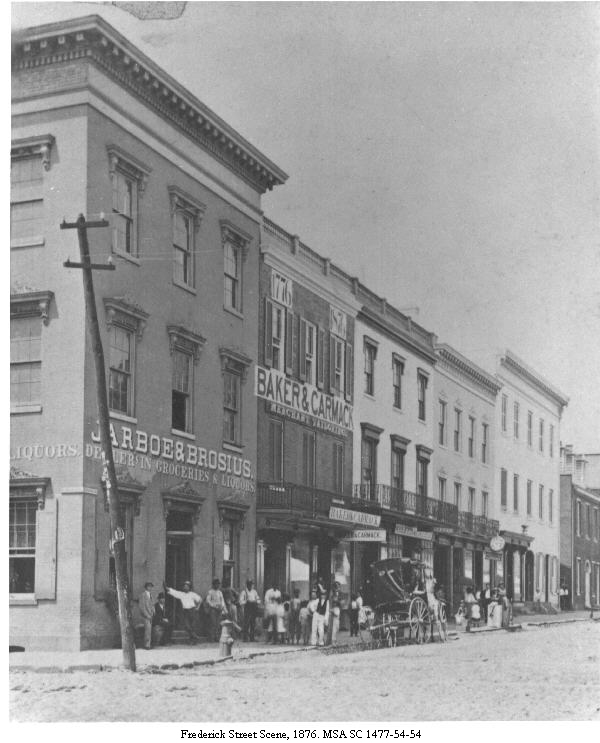
The General Assembly Moves to Frederick, 1861
In early 1861, Maryland was walking a tightrope between the Union and the Confederacy. In addition to being physically between the two sides, Maryland depended equally on the North and the South for its economy. Although Maryland had always leaned toward the south culturally, sympathies in the state were as much pro-Union as they were pro-Confederate. Reflecting that division and the feeling of many Marylanders that they just wanted to be left alone, the state government would not declare for either side.
For the Federal Government, however, there was no question about which side Maryland had to take. If she seceded, Washington D.C. would be surrounded by hostile states, effectively cut off from the rest of the Union. The situation came to a head on April 19, 1861, when the soldiers of the 6th Massachusetts Volunteers, moving through Baltimore on the way to Washington, were attacked by a pro-Southern mob. When the mob started shooting at the regiment, the soldiers returned fire, and when the smoke had cleared, four soldiers and twelve civilians had been killed.
To avoid further riots, it was decided to send troops through the Naval Academy at Annapolis. To ensure the safety of the troops and the loyalty of the state government, the Federal Government sent General Benjamin F. Butler to Annapolis to secure the city on April 22. That same day, Governor Thomas Holliday Hicks decided to call a special session of the General Assembly to discuss the crisis. At that time, the General Assembly met biannually, but popular outcry was so strong that the governor felt it necessary to call together the Assembly during an off year. However, he probably felt that anti-Union sentiment would run high in a city that had just been occupied by Northern troops, so Governor Hicks decided to convene the Legislature in Frederick, Maryland, a strongly pro-Union city.
The General Assembly first met in the Frederick County Courthouse on April 26. However, it was quickly found that the courthouse was too small, and so, on the second day, the Assembly moved to Kemp Hall the meeting hall belonging to the German Reformed Church. On April 30, the weekly Frederick Herald reported: "The Legislature seems comfortable and well provided for in their new halls in the German Reformed Building. The Senate occupies the Red Men's Hall, third story -- the House, the hall in the second story. These halls have been tastefully and appropriately fitted up for their purposes."
The main topic of discussion in those tastefully appointed halls was, of course, the question of whether or not to secede from the Union. As the General Assembly met throughout the long summer, a bill and a resolution were introduced calling for secession. Both failed because the legislators said that they did not have the authority to secede from the Union. Even many of the pro-Southern delegates and senators did not support the bills. At the same time, however, the legislators refused to reopen rail links to the Northern States, for fear the they would be used for military purposes and also by pro-Union agitators bent on revenge for the Baltimore riots. One of the few things the General Assembly did agree upon was a resolution sent to President Lincoln protesting the Union occupation of Maryland. It seems that the General Assembly was primarily interested in preserving Maryland's neutrality, for they neither wanted to secede from the Union, nor to allow Union troops to cross its territory in order to attack the Confederacy.
On August 7, the General Assembly adjourned, intending to meet again on September 17. However, on that day Federal troops and Baltimore police officers arrived in Frederick with orders to arrest the pro-Confederate members of the General Assembly. Thus, the special session in Frederick ended, as did Frederick's summer as the state capital, as Maryland found itself inexorably drawn further and further into the heart of the bloodiest war in American history.
By 1863, the barracks at the U. S. Naval Academy and St. John's College had become badly overcrowded, since Annapolis had become the most important depot for paroled prisoners on the coast. As a result, a larger facility named Camp Parole was built outside of Annapolis. At these facilities, Union prisoners paroled from Confederate prisons could get a bath, a shave, fresh clothing, and in some cases badly needed medical attention. The soldiers would then stay at Camp Parole until they could be either sent home or rejoin their regiments. This is the only known photograph of the Parole barracks and it includes a portrait of the band in front of the camp headquarters.
Bibliography
Brugger, Robert J. Maryland: A Middle Temperament, 1694-1980. Baltimore: The Johns Hopkins University Press; 1988.
Maryland State Archives. MARYLAND STATE ARCHIVES (Maryland Guide Files) "Frederick City" [MSA T 1390, 2/11/10/07].
Papenfuse, Edward C. et al. Maryland: A New Guide to the Old Line State. Baltimore: The Johns Hopkins University Press; 1976.
Radoff, Morris L. The County Courthouses and Records of Maryland, Part One: The Courthouses. Annapolis: The Hall of Records Commission, State of Maryland; 1960.
Warren, Mame and Marion E. Everybody Works But John Paul Jones: A Portrait of the U. S. Naval Academy, 1845-1915. Annapolis: Naval Institute Press; 1981.
Whitmore, Nancy F. and Timothy L. Cannon. Frederick: A Pictorial History. Norfolk: The Donning Co.; 1981
Williams, T. J. C. and Folger McKinsey. History of Frederick County, Maryland. Baltimore: Regional Publishing Company, 1910 reprinted 1967.
Works Project Administration, Writer's Program in the State of Maryland. Maryland: A Guide to the Old Line State. New York: Oxford University Press; 1934.
|
Tell Us What You Think About the Maryland State Archives Website!
|